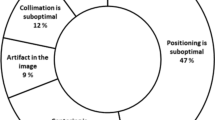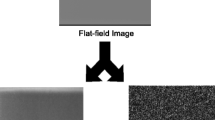Abstract
A large database of digital chest radiographs was developed over a 14-month period. Ten radiographic technologists and five radiologists independently evaluated a stratified subset of images from the database for quality deficiencies and decided whether each image should be rejected. The evaluation results showed that the radiographic technologists and radiologists agreed only moderately in their assessments. When compared against each other, radiologist and technologist reader groups were found to have even less agreement than the inter-reader agreement within each group. Radiologists were found to be more accepting of limited-quality studies than technologists. Evidence from the study suggests that the technologists weighted their reject decisions more heavily on objective technical attributes, while the radiologists weighted their decisions more heavily on diagnostic interpretability relative to the image indication. A suite of reject-detection algorithms was independently run on the images in the database. The algorithms detected 4 % of postero-anterior chest exams that were accepted by the technologist who originally captured the image but which would have been rejected by the technologist peer group. When algorithm results were made available to the technologists during the study, there was no improvement in inter-reader agreement in deciding whether to reject an image. The algorithm results do, however, provide new quality information that could be captured within a site-wide, reject-tracking database and leveraged as part of a site-wide QA program.



Similar content being viewed by others
References
IMV Medical Information Division: 2010 X-ray/DR/CR market outlook report. November 2010
Foos DH, Sehnert WJ, Reiner B, Siegel EL, Segal A, Waldman DL: Digital radiography reject analysis: data collection methodology, results, and recommendations from an in-depth investigation at two hospitals. J Digit Imaging 22:89–98, 2009
Jones AK, Polman R, Willis CE, Shepard SJ: One year’s results from a server-based system for performing reject analysis and exposure analysis in computed radiography. J Digit Imaging 24(2):243–255, 2011
Tzeng W, Kuo K, Liu C, Yao H, Chen C, Lin H: Managing repeated digital radiography images—a systematic approach and improvement. J Med Syst 36(4):2697–2704, 2012. doi:10.1007/s10916-011-9744-8
Reiner B: Automating quality assurance for digital radiography. J Am Coll Radiol 6:486–490, 2009
Reiner B, Siegel E, Sehnert WJ: Beauty in the Eyes of the Beholder: Image Quality Perceptions for Digital Radiography. Presented at: Society of Imaging Informatics in Medicine, Seattle, May 17, 2008
Shet N, Chen J, Siegel E: Continuing challenges in defining image quality. Pediatr Radiol 41(5):582–587, 2011
Reiner BI, Siegel E, Foos D: Quantitative analysis of digital radiography QA deficiencies. In: Abstracts of the Annual Meeting of the Society for Imaging Informatics in Medicine. Providence, 2007
Waaler D, Hofmann B: Image rejects/retakes—radiographic challenges. Radiat Prot Dosim 139(1–3):375–379, 2010
Nagy PG, Pierce B, Otto M, Safdar NM: Quality control management and communication between radiologists and technologists. J Am Coll Radiol 5(6):759–765, 2008
Minnigh TR, Gallet J: Maintaining quality control using a radiological digital X-ray dashboard. J Digit Imaging 22(1):84–88, 2009
Prieto C, Vano E, Ten JI, Fernandez JM, Iñiguez AI, Arevalo N, Litcheva A, Crespo E, Floriano A, Martinez D: Image retake analysis in digital radiography using DICOM header information. J Digit Imaging 22(4):393–399, 2009
Meyer-Base A: Pattern Recognition for Medical Imaging: Application of Statistical Classification Methods in Biomedical Imaging. Elsevier Academic, San Diego, 2004
Zhang P, Varma B, Kumar K: Neural vs. statistical classifier in conjunction with genetic algorithm feature selection in digital mammography. The 2003 Congress on Evolutionary Computation 2:1206–1213, doi:10.1109/CEC.2003.1299806, December 8–12, 2003
Castro A, Boveda C, Arcay B: Comparison of various fuzzy clustering algorithms in the detection of ROI in lung CT and a modified kernelized-spatial fuzzy c-means algorithm. 2010 10th IEEE International Conference on Information Technology and Applications in Biomedicine, 1–4, doi:10.1109/ITAB.2010.5687726, November 3–5, 2010
Rale AP, Gharpure DC, Ravindran VR: Comparison of different ANN techniques for automatic defect detection in X-ray images. Int Conf Emerg Trends Electron Photon Devices Syst 2009:193–197, 2009
Shiraishi J, Li Q, Appelbaum D: Computer-aided diagnosis and artificial intelligence in clinical imaging. Semin Nucl Med 41(6):449–462, 2011
Dayhoff JE, DeLeo JM: Artificial neural networks: opening the black box. Cancer 91:1615–1635, 2001
Luo H, Sehnert WJ, Ellinwood JS: Method for Detecting Anatomical Motion Blur in Diagnostic Images. Patent US7899229B2, March 1, 2011
Luo H: Method for Detecting Clipped Anatomy in Medical Images. Patent US7912263B2, March 22, 2011
Hamel L: Knowledge Discovery with Support Vector Machines. Wiley, Hoboken, 2009
Gallet J: The Concept of Exposure Index for Carestream Directview Systems. Carestream Technical Brief Series. CAT No. 120 7091, 2010
Radiological Society of North America: RadLex: A Lexicon for Uniform Indexing and Retrieval of Radiology Information Resources. http://www.rsna.org/radlex/. Accessed 09 April 2010
Cohen J: A coefficient of agreement for nominal scales. Educ Psychol Meas 20(1):37–46, 1960
Birger H: The foundation of the concept of relevance. J Am Soc Inf Sci 61(2):217–237, 2010
Landis JR, Koch GG: The measurement of observer agreement for categorical data. Biometrics 33:159–174, 1977
Author information
Authors and Affiliations
Corresponding author
Rights and permissions
About this article
Cite this article
Whaley, J.S., Pressman, B.D., Wilson, J.R. et al. Investigation of the Variability in the Assessment of Digital Chest X-ray Image Quality. J Digit Imaging 26, 217–226 (2013). https://doi.org/10.1007/s10278-012-9515-1
Published:
Issue Date:
DOI: https://doi.org/10.1007/s10278-012-9515-1




